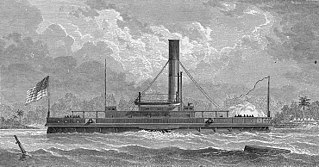
USS Housatonic was a screw sloop-of-war of the United States Navy, gaining its namesake from the Housatonic River of New England.

The first USS Ellen was a side-wheel steam gunboat in the United States Navy during the American Civil War.

The first USS Pocahontas, a screw steamer built at Medford, Massachusetts in 1852 as City of Boston, and purchased by the Navy at Boston, Massachusetts on 20 March 1855, was the first United States Navy ship to be named for Pocahontas, the Algonquian wife of Virginia colonist John Rolfe. She was originally commissioned as USS Despatch – the second U.S. Navy ship of that name – on 17 January 1856, with Lieutenant T. M. Crossan in command, and was recommissioned and renamed in 1860, seeing action in the American Civil War. As Pocahontas, one of her junior officers was Alfred Thayer Mahan, who would later achieve international fame as a military writer and theorist of naval power.

The siege of Fort Pulaski concluded with the Battle of Fort Pulaski fought April 10–11, 1862, during the American Civil War. Union forces on Tybee Island and naval operations conducted a 112-day siege, then captured the Confederate-held Fort Pulaski after a 30-hour bombardment. The siege and battle are important for innovative use of rifled guns which made existing coastal defenses obsolete. The Union initiated large-scale amphibious operations under fire.
USS Flag was a screw steamship in the Union Navy during the American Civil War. She is listed as "3rd rate".
USS Rebecca Sims was built as a general trading ship in 1801 by Samuel Bowers of Philadelphia, Pennsylvania, for Joseph Sims.
USS Tenedos, abark of 245 tons, 300 feet (91 m) long, was originally a Pacific whaler, owned by Lawrence and Company of New London, Connecticut. During the American Civil War, the United States Navy purchased her on 16 October 1861 for use in the "Stone Fleet," a group of ships to be sunk as obstructions along the coast of the Confederate States of America. Under the command of Master O. Sisson, she was sunk as blockship in Charleston Harbor off Charleston, South Carolina, on 19 or 20 December 1861.
USS Robin Hood was a 400-foot-long (120 m) ship of 395 tons, purchased by the United States Navy in Mystic, Connecticut, during the American Civil War on 20 October 1861 for use in the "Stone Fleet." In December 1861 she was sunk as an obstruction in Charleston Harbor off Charleston, South Carolina.
USS South America (1861) was a whaler purchased by the Union Navy on 9 November 1861 at New London, Connecticut. She was acquired to be sunk as an obstruction in the channel leading to a Confederate port as part of the Union blockade on ports and waterways of the Confederate States of America.
The first USS Meteor retained her commercial name when the United States Navy purchased her for the "Stone Fleet." She was sunk as an obstruction in Charleston Harbor off Charleston, South Carolina, in January 1862.
USS Amazon was a wooden-hulled bark of 318 tons that had previously sailed as a whaler out of Fairhaven, Massachusetts.
USS Peri was one of the ships of the Stone Fleet, sunk in the harbor of Charleston, South Carolina as a blockade during the American Civil War.
The Phoenix was a 404-ton American wooden whaler based in New London, Connecticut. The Union Navy purchased Phoenix at New London on 9 November 1861, at the start of the American Civil War. The Navy wanted her for the Stone Fleet, a group of vessels to be sunk in the channels of important Southern harbors to interrupt Confederate trade. She sailed on the 20th but grounded while crossing Savannah Bar, lost her rudder, and began leaking badly. When refloated she was beached as a breakwater to shelter Union troops landing on Tybee Island, Georgia, on or before 5 December 1861, in preparation for the Battle of Fort Pulaski.
USS American was a bark of 329 tons, a former whaler, purchased 1 November 1861 at Edgartown, Massachusetts for the Stone Fleet at a cost of $3,370. She left New Bedford, Massachusetts on 20 November 1861, and was intentionally sunk as an obstruction to shipping in the main channel of the harbor of Charleston, South Carolina on 20 December 1861. This ship has sometimes been recorded as America.
USS Timor was purchased at Sag Harbor, New York on 30 October 1861. She was sunk as part of the Stone Fleet at Maffitts channel in Charleston harbor on 25 or 26 January 1862.
USS Stephen Young was one of the ships of the Stone Fleet, sunk in the harbor of Charleston, South Carolina to be used as a blockade during the American Civil War.
USS Valparaiso was a Navy vessel that was given a "second life" in her nautical career. During the start of the American Civil War, she was destined to be used as a "stone ship" hazard to navigation sunk in a Southern harbor, but the Union Navy reconsidered and put her to work as a stores ship, supporting the blockade of the ports of the Confederate States of America.
USS Garland was a bark acquired by the Union Navy during the American Civil War. The Navy planned on using her as part of the stone fleet; however, because of the Union Army's need for a supply ship, she was transferred to that service for the duration of the entire war.
USS Noble (1861) was a wooden bark purchased during the American Civil War by the Union Navy 2 December 1861 at Sag Harbor, New York.




